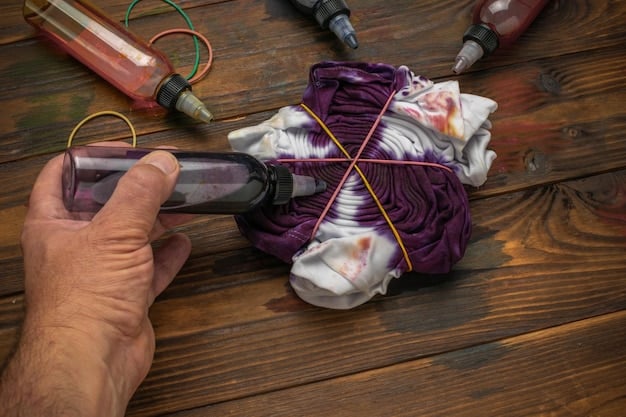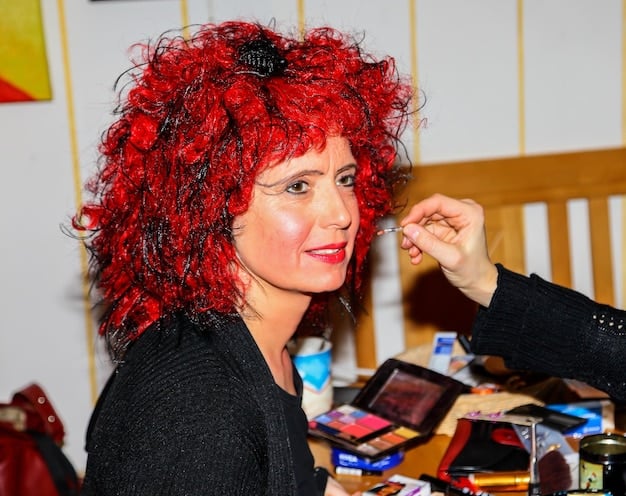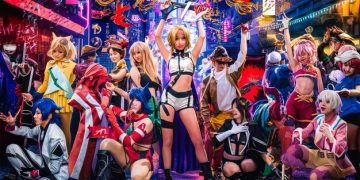The Ultimate Guide to Cosplay: Transforming into Your Favorite Characters

Cosplay, short for “costume play,” is a vibrant and creative subculture of Geek Lifestyle where enthusiasts transform into their favorite characters from video games, anime, comics, and other forms of media through crafting and wearing intricately designed costumes.
Cosplay is more than just wearing a costume; it’s an art form, a hobby, and a community. It’s about bringing fictional characters to life and sharing your passion with others. Whether you’re a seasoned pro or just starting out, this guide will provide you with the knowledge and inspiration you need to dive into the world of cosplay.
What is Cosplay? Unveiling the Art of Costume Play
Cosplay, a portmanteau of “costume” and “play,” is an activity and performance art where participants wear costumes and accessories to represent a specific character. But what truly defines this activity beyond just dressing up?
It’s the dedication, artistry, and community that elevates cosplay to another level. It is a dynamic art form that blends creativity, craftsmanship, and performance.
The Origins of Cosplay
While dressing up in costumes has been around for centuries, the modern concept of cosplay can be traced back to science fiction conventions in the United States in the late 1930s. However, the term “cosplay” itself originated in Japan in the 1980s, coined by Nobuyuki Takahashi after attending a science fiction convention in Los Angeles.
Since then, Cosplay has evolved into a global phenomenon, with conventions and events dedicated to it taking place all over the world.
The Different Types of Cosplay
Cosplay encompasses a wide range of character representations influenced by different sources. Here are just a few:
- Anime and Manga Cosplay: Representing characters from Japanese animation and comics.
- Video Game Cosplay: Bringing characters from the digital world to life.
- Comic Book Cosplay: Emulating heroes and villains from the pages of comic books.
- Original Design Cosplay: Creating unique interpretations of existing characters or designing entirely new ones.
Cosplay goes beyond just mimicking a character’s attire. It involves embodying their personality, mannerisms, and iconic poses. Cosplayers often spend hours perfecting their character’s voice, practicing their signature moves, and studying their backstory to fully immerse themselves in the role.

Getting Started with Cosplay: A Beginner’s Guide
The world of cosplay can seem overwhelming at first, especially for beginners. But don’t worry, getting started is easier than you might think. The goal is to have fun and be creative.
There are key steps to consider that will help you to enjoy the process of creating a great cosplay.
Choosing Your Character
The first step is to choose a character that you’re passionate about. This could be a character from your favorite anime, video game, comic book, or movie. Consider a character that resonates with you in some way.
Pick someone whose personality you admire, or whose fashion you love. When picking the character, think about the complexity of the costume because it can be difficult for beginners to start with complicated characters.
Gathering Materials and Tools
Once you’ve chosen your character, it’s time to gather the necessary materials and tools. This will depend on the complexity of your costume, but some common items include:
- Fabric
- Foam
- Worbla
- Paints
- Sewing machine
- Craft knife
- Hot glue gun
It is important to keep in mind that there are different vendors where you can buy these materials to help you get started. Also, you need to research different materials before you buy them.
Basic Sewing Techniques for Cosplay
Sewing is an essential skill for many cosplay projects. If you’re new to sewing, start with the basics. Learning to sew straight lines, curves, and darts will be invaluable in creating your costume.
There are a lot of youtube channels and tutorials online to help you get started and help you learn some extra skills.
Starting with cosplay involves choosing the right tools and materials and having some sewing techniques, which are important as you create your cosplay. Ultimately, the most important thing is to have fun while doing it.
Mastering Cosplay Crafting: Techniques and Tips
Crafting is a crucial aspect of cosplay, allowing you to create intricate details and bring your character to life. There are important crafting techniques and materials that you can master.
It is important to keep in mind that there are different levels of crafting, starting from basic to more complicated ones.
Working with Foam
Foam is a versatile material that’s widely used in cosplay for creating armor, props, and accessories. It’s lightweight, easy to shape, and relatively inexpensive.
To work with foam effectively, you’ll need a sharp craft knife, heat gun, contact cement, and paints. By using a heat gun, it will help you to seal and to shape the foam and to give it the desired form.
Creating Realistic Props
Props are essential for completing your cosplay and adding authenticity to your character. Whether it’s a sword, staff, or gun, a well-crafted prop can make all the difference.
When creating props, consider using a variety of materials to achieve the desired effect. Foam, wood, PVC pipes, and 3D-printed parts can all be combined to create realistic and durable props.
Adding Details with Painting and Weathering
Painting and weathering are crucial for adding depth, texture, and realism to your cosplay. Experiment with different painting techniques to achieve the desired look.
- Dry brushing: This helps create a worn and weathered appearance.
- Washing: Applying a thin layer of paint to recesses to add shadows and depth.
- Highlighting: Accentuating raised areas to enhance details and create contrast.
Mastering crafting techniques allows you to bring intricacy to your character. You will master these techniques with practice over time as well which can enhance your cosplay experience.
Cosplay Makeup and Wigs: Completing Your Transformation
Makeup and wigs are essential tools for completing your cosplay and truly transforming into your chosen character. These are the ultimate touches that add authenticity to your presence.
You need to consider what kind of makeup and wig to choose, as well as the character’s specific style. With practice and attention to detail, you can achieve stunning transformations.
Choosing the Right Makeup
When choosing makeup for cosplay, consider the character’s skin tone, facial features, and overall aesthetic. Invest in high-quality products that will last throughout the day and photograph well.
You can use makeup to enhance your natural features or to completely transform your appearance. Experiment with contouring, highlighting, and shading to sculpt your face and create the illusion of different bone structures.
Styling and Caring for Wigs
Wigs are a staple in cosplay, allowing you to instantly change your hairstyle and color without damaging your natural hair. Invest in high-quality wigs that are easy to style and maintain.
When styling your wig, start by brushing it out to remove any tangles or knots. Use a wig-styling comb or brush to avoid damaging the fibers. Experiment with different styling techniques, such as teasing, curling, or straightening, to achieve the desired look.
Creating Special Effects with Makeup
For more advanced cosplay looks, consider incorporating special effects makeup to create wounds, scars, or other unique features. Liquid latex, prosthetic pieces, and theatrical blood can all be used to add realism to your cosplay.
By experimenting with makeup and taking care of wigs, the final touch of authenticity to your transformation will be achieved.

Cosplay Etiquette and Community: Respect and Inclusion
Cosplay is more than just a hobby; it’s a community. Like any community, there are certain etiquette guidelines that should be followed to ensure a positive and inclusive experience for everyone.
It is important to remember that cosplay is for everyone to participate and to be able to embrace a shared passion.
Respecting Personal Boundaries
Always ask for permission before taking someone’s photo, touching their costume, or approaching them for a conversation. Not everyone is comfortable with physical contact or being photographed.
Be mindful of personal space and avoid making assumptions about someone’s gender, sexuality, or background. Respecting personal boundaries is essential.
Creating an Inclusive Environment
Cosplay is for everyone, regardless of their race, gender, body type, or skill level. Create an inclusive environment where everyone feels welcome and supported.
Avoid making derogatory comments about someone’s cosplay or appearance. Offer constructive criticism only when asked, and always be respectful and encouraging.
Promoting Positive Interactions
Engage in positive interactions with other cosplayers and attendees. Compliment their costumes, ask about their crafting process, and share tips and tricks.
- Participate in group photoshoots and collaborative projects.
- Offer assistance to those who need it.
- Most importantly, have fun and enjoy the experience.
Practicing respect and inclusivity is very important and ensures that the cosplay community will thrive in the years to come as a safe and supportive space.
Level Up Your Cosplay: Advanced Techniques and Tips
As you gain experience in cosplay, you may want to explore more advanced techniques and tips to elevate your creations to the next level. Consider exploring more advanced techniques.
Mastering advanced skills can help you to bring your characters to life with more authenticity.
3D Printing for Cosplay
3D printing has revolutionized the world of cosplay, allowing cosplayers to create highly detailed and accurate props, armor pieces, and accessories. A lot of people consider it an investment for their cosplay creations.
If you want to learn more about 3D printing, investing in a 3D printer or attending a workshop may be beneficial as you can unleash your creativity.
Advanced Sewing and Pattern Making
Mastering advanced sewing techniques, such as tailoring, draping, and pattern making, can take your cosplay costumes to the next level. Learning how to create custom patterns tailored to your specific measurements will result in a better-fitting and more professional-looking costume.
Always consider spending time on the basics of sewing, there are different resources you can find online to provide the basics.
Working with Electronics and Lighting
Adding electronics and lighting to your cosplay can create stunning visual effects and make your character truly stand out. LED lights, EL wire, and microcontrollers can be used to create glowing eyes, illuminated weapons, or animated armor pieces.
Advanced techniques when it comes to creating cosplay ultimately lie in a combination of skills, creativity and a commitment to learning and practicing. Embrace challenges and use them as opportunities for learning and growing as a cosplayer.
| Key Aspects | Brief Description |
|---|---|
| 💡 Character Selection | Choose a character you are passionate about and whose costume complexity matches your skill level. |
| 🛠️ Materials and Tools | Gather fabrics, foam, and essential tools that suit your costume build and can be found in various vendor stores. |
| 🎭 Makeup and Wigs | Use makeup and quality wigs to complete your transformation, while mastering different styles that are authentic to the character. |
| 🤝 Community Respect | Follow etiquette guidelines respecting personal spaces to foster positive interactions. |
Frequently Asked Questions about Cosplay
Consider characters you love and whose costumes fit your abilities. Start simple and choose characters whose personality and style you genuinely admire.
A sewing machine, craft knife, hot glue gun, and a variety of paints and fabrics are essential. Investing in quality materials will help make your cosplay stand out.
Start with basic stitches and practice regularly. Watching online tutorials and taking classes can also improve your sewing skills. Don’t be afraid to make mistakes; each project will teach you something new.
Look to official character art, cosplay communities, and social media platforms like Instagram and Pinterest. These platforms can provide you with different ideas and styles allowing you to create quality cosplay.
Always bring a cosplay repair kit with items like safety pins, fabric glue, and extra thread that will quickly address any issues that may appear. Having a repair kit is always a good idea when you go to these conventions.
Conclusion
Cosplay is an incredibly rewarding hobby that combines creativity, craftsmanship, and community. Whether you’re a beginner or an experienced cosplayer, there’s always something new to learn and explore. By following the tips and techniques outlined in this guide, you’ll be well on your way to creating amazing cosplay costumes and sharing your passion with the world. Embrace the challenge, have fun with the process, and never stop learning.





